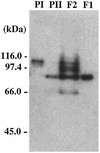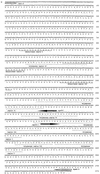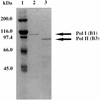Two family B DNA polymerases from Aeropyrum pernix, an aerobic hyperthermophilic crenarchaeote
- PMID: 10498710
- PMCID: PMC103625
- DOI: 10.1128/JB.181.19.5984-5992.1999
Two family B DNA polymerases from Aeropyrum pernix, an aerobic hyperthermophilic crenarchaeote
Abstract
DNA polymerase activities in fractionated cell extract of Aeropyrum pernix, a hyperthermophilic crenarchaeote, were investigated. Aphidicolin-sensitive (fraction I) and aphidicolin-resistant (fraction II) activities were detected. The activity in fraction I was more heat stable than that in fraction II. Two different genes (polA and polB) encoding family B DNA polymerases were cloned from the organism by PCR using degenerated primers based on the two conserved motifs (motif A and B). The deduced amino acid sequences from their entire coding regions contained all of the motifs identified in family B DNA polymerases for 3'-->5' exonuclease and polymerase activities. The product of polA gene (Pol I) was aphidicolin resistant and heat stable up to 80 degrees C. In contrast, the product of polB gene (Pol II) was aphidicolin sensitive and stable at 95 degrees C. These properties of Pol I and Pol II are similar to those of fractions II and I, respectively, and moreover, those of Pol I and Pol II of Pyrodictium occultum. The deduced amino acid sequence of A. pernix Pol I exhibited the highest identities to archaeal family B DNA polymerase homologs found only in the crenarchaeotes (group I), while Pol II exhibited identities to homologs found in both euryarchaeotes and crenarchaeotes (group II). These results provide further evidence that the subdomain Crenarchaeota has two family B DNA polymerases. Furthermore, at least two DNA polymerases work in the crenarchaeal cells, as found in euryarchaeotes, which contain one family B DNA polymerase and one heterodimeric DNA polymerase of a novel family.
Figures








Similar articles
-
Three proliferating cell nuclear antigen-like proteins found in the hyperthermophilic archaeon Aeropyrum pernix: interactions with the two DNA polymerases.J Bacteriol. 2002 Feb;184(3):687-94. doi: 10.1128/JB.184.3.687-694.2002. J Bacteriol. 2002. PMID: 11790738 Free PMC article.
-
The hyperthermophilic archaeon Pyrodictium occultum has two alpha-like DNA polymerases.J Bacteriol. 1995 Apr;177(8):2164-77. doi: 10.1128/jb.177.8.2164-2177.1995. J Bacteriol. 1995. PMID: 7721707 Free PMC article.
-
Cloning and characterization of a family B DNA polymerase from the hyperthermophilic crenarchaeon Pyrobaculum islandicum.J Bacteriol. 2000 Feb;182(3):655-63. doi: 10.1128/JB.182.3.655-663.2000. J Bacteriol. 2000. PMID: 10633098 Free PMC article.
-
The euryarchaeotes, a subdomain of Archaea, survive on a single DNA polymerase: fact or farce?Genes Genet Syst. 1998 Dec;73(6):323-36. doi: 10.1266/ggs.73.323. Genes Genet Syst. 1998. PMID: 10333564 Review.
-
Archaeal DNA replication: identifying the pieces to solve a puzzle.Genetics. 1999 Aug;152(4):1249-67. doi: 10.1093/genetics/152.4.1249. Genetics. 1999. PMID: 10430556 Free PMC article. Review.
Cited by
-
A korarchaeal genome reveals insights into the evolution of the Archaea.Proc Natl Acad Sci U S A. 2008 Jun 10;105(23):8102-7. doi: 10.1073/pnas.0801980105. Epub 2008 Jun 5. Proc Natl Acad Sci U S A. 2008. PMID: 18535141 Free PMC article.
-
A transposon-derived DNA polymerase from Entamoeba histolytica displays intrinsic strand displacement, processivity and lesion bypass.PLoS One. 2012;7(11):e49964. doi: 10.1371/journal.pone.0049964. Epub 2012 Nov 30. PLoS One. 2012. PMID: 23226232 Free PMC article.
-
Three proliferating cell nuclear antigen-like proteins found in the hyperthermophilic archaeon Aeropyrum pernix: interactions with the two DNA polymerases.J Bacteriol. 2002 Feb;184(3):687-94. doi: 10.1128/JB.184.3.687-694.2002. J Bacteriol. 2002. PMID: 11790738 Free PMC article.
-
DNA polymerases as useful reagents for biotechnology - the history of developmental research in the field.Front Microbiol. 2014 Aug 29;5:465. doi: 10.3389/fmicb.2014.00465. eCollection 2014. Front Microbiol. 2014. PMID: 25221550 Free PMC article. Review.
-
Towards understanding the first genome sequence of a crenarchaeon by genome annotation using clusters of orthologous groups of proteins (COGs).Genome Biol. 2000;1(5):RESEARCH0009. doi: 10.1186/gb-2000-1-5-research0009. Epub 2000 Nov 6. Genome Biol. 2000. PMID: 11178258 Free PMC article.
References
-
- Bernad A, Blanco L, Lazaro J M, Martin G, Salas M. A conserved 3′→5′ exonuclease active site in prokaryotic and eukaryotic DNA polymerases. Cell. 1989;59:219–228. - PubMed
-
- Bult C J, White O, Olsen G J, Zhou L, Fleischmann R D, Sutton G G, Blake J A, FitzGerald L M, Clayton R A, Gocayne J D, Kerlavage A R, Dougherty B A, Tomb J-F, Adams M D, Reich C I, Overbeek R, Kirkness E F, Weinstock K G, Merrick J M, Glodek A, Scott J L, Geoghagen N S M, Weidman J F, Fuhrmann J L, Presley E A, Nguyen D, Utterback T R, Kelley J M, Peterson J D, Sadow P W, Hanna M C, Cotton M D, Hurst M A, Roberts K M, Kaine B P, Borodovsky M, Klenk H-P, Fraser C M, Smith H O, Woese C R, Venter J C. Complete genome sequence of the methanogenic archaeon, Methanococcus jannaschii. Science. 1996;273:1058–1073. - PubMed
-
- Cann, I. K. O., S. Ishino, I. Hayashi, K. Komori, H. Toh, K. Morikawa, and Y. Ishino. Unpublished data.
MeSH terms
Substances
Associated data
- Actions
- Actions
LinkOut - more resources
Full Text Sources
Other Literature Sources

